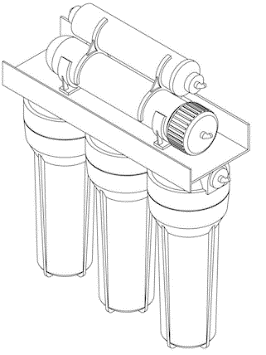What should I do if my ice maker does not produce enough ice?
A few factors can cause an ice maker to not work. If the ice maker appears to not be making any or enough ice, low water pressure or a faulty water filter may be to blame. When the ice maker makes small, cloudy, or clumped ice, it could be something as simple as a dirty water filter, low water pressure, or high mineral deposits in your water. In the event of an ice bucket, some troubleshooting may be needed, and service may be required.
Although the ice maker is capable of making 10 pounds of ice a day, it's only capable of holding 2 pounds of ice at a time. Once the ice bucket is full, the ice maker will stop.
Additionally, if ice is not dispensed regularly, it will pile up underneath the ice maker and prevent ice production. Shifting the ice forward will fix this problem.
If a significant amount of ice is needed, periodically empty the extra ice into bags and keep them in the freezer, so the bucket can make additional batches of ice.

Note: If your model does not have a dispenser, skip to step 3.
Your water line should have enough pressure to fill 6 ounces (3/4 cup) in less than 10 seconds. Just dispense water into a measuring cup.
If no water dispenses at all, verify that the water line is connected. See more troubleshooting in our guide.

Note: If your model has a dispenser and it passed the water pressure test, skip to step 5. If your model doesn't have a water filter, skip to step 4.
If your model has a dispenser, remove the water filter and try the water pressure test again. If the dispenser failed the water pressure test at first but now it passes, then you need to replace the filter. Use only Samsung brand filters.
If your dispenser only passes the water pressure test when the filter is removed, but it's a new filter, then your water pressure is too low. Move to step 4.
If your model doesn't have a dispenser, then you need to judge for yourself if it's time for a filter replacement. Water filters are rated for 300 gallons of usage, which in an average household, represents about 6 months of usage. If it's been a while since the last time you replaced the filter, try removing it and checking if the ice production issue is resolved. If that fixes the ice production issue, then you need to replace the filter. Use only Samsung brand filters.

Note: Skip step 4 if all of the following are true: (1) the model does not have a dispenser, (2) the ice maker has worked properly before, and (3) there is no reason the water pressure would have recently changed. (As in, the fridge has not been recently moved or the water line recently adjusted.)
Since water pressure is not controlled by the refrigerator, it will need to be adjusted at the source. The step you can take immediately is to make sure the home's water supply valve is fully open.
If that doesn't increase the water pressure enough (20 psi is required), contact a plumber for further assistance. Service is not required and no further troubleshooting is needed until the water pressure issue is resolved.
If you're using a Reverse Osmosis system to filter water, this may cause the water pressure to be too low. In this case, contact a plumber for assistance in increasing water pressure.

Many refrigerator issues stem from improper leveling. Therefore, you should make sure the fridge is level.

Your ice maker works best when the fridge's doors stay closed. Opening the door pauses ice production and allows warm air to enter the fridge, making it take longer to freeze ice.
If you increase the cooling performance of your fridge, it should reduce the time it takes to freeze ice cubes.

However, if your refrigerator is not making ice and is also displaying an error code, you can review our error code guide for further troubleshooting.

Thank you for your feedback!
Please answer all questions.